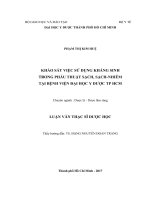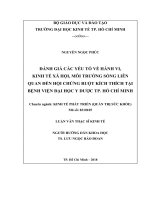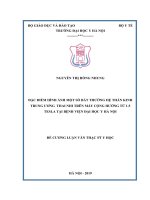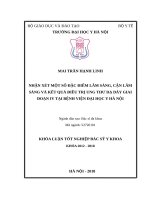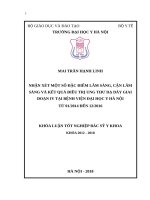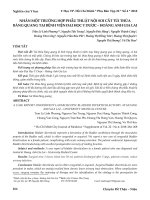Đặc điểm giải phẫu dây thần kinh quặt ngược thanh quản ở đoạn cổ trên người trưởng thành tại bệnh viện đại học y dược và bộ môn giải phẫu
Bạn đang xem bản rút gọn của tài liệu. Xem và tải ngay bản đầy đủ của tài liệu tại đây (3.45 MB, 105 trang )
.
O
V
OT O
Ọ
Ƣ
T
T
N
P
MN
--o0o--
N U ỄN TRUN
Ặ
ỂM
 T ẦN K N
N U ÊN
Ả P ẪU
QUẶT N Ƣ
T AN
Ở O N Ổ TRÊN N ƢỜ TRƢỞN
T
ỆN
V ỆN
V
Ọ
MÔN
T
Ƣ
Ả P ẪU
CHUYÊN NGÀNH: TAI MŨI HỌNG
MÃ SỐ: NT 62 72 53 01
LUẬN VĂN T T N
N ƢỜ
ƢỚN
PGS.TS.BS LÂM
ỆP
SĨ N
ẪN K OA
Ọ
U ỀN TRÂN
THÀNH PHỐ HỒ CHÍ MINH – 2020
.
TRÚ
QUẢN
N
.
LỜ
AM OAN
Tôi là Nguyễn Trung Nguyên, bác sĩ nội trú chuyên ngành Tai Mũi Họng, khóa
2017 – 2020, trường Đại học Y dược Thành phố Hồ Chí Minh.
Tơi xin cam đoan đề tài: “Đặc điểm giải phẫu dây thần kinh quặt ngược thanh
quản ở đoạn cổ trên người trưởng thành tại Bệnh viện Đại học Y Dược và Bộ môn
Giải phẫu” là một cơng trình nghiên cứu độc lập dưới sự hướng dẫn của
PGS.TS.Lâm Huyền Trân. Ngồi ra khơng có bất cứ sự sao chép của người khác.
Đề tài, nội dung báo cáo là sản phẩm mà tôi đã nỗ lực nghiên cứu trong quá trình
học tập và thực hành. Các số liệu, kết quả trình bày trong báo cáo là hồn tồn trung
thực, chính xác, khách quan và chưa từng được công bố trong bất kỳ nghiên cứu
nào khác.
TP. Hồ Chí Minh, ngày 28 tháng 09 năm 2020
Ký tên
NGUYỄN TRUNG NGUYÊN
.
.
M CL C
Trang
AN
M
TỪ V
T TẮT............................................................................................. i
AN
M
AN
M
ÌN ................................................................................................ iii
AN
M
ẢN ................................................................................................ v
AN
M
AN
M
U AN
ỂU
SƠ
- V ỆT ......................................................................... ii
.................................................................................................... vi
....................................................................................................... vii
ẶT VẤN Ề .................................................................................................................... 1
ƢƠN
1: TỔN
QUAN T
L ỆU .......................................................................... 3
1.1 Lịch sử ...................................................................................................................... 3
1.2 Đặc điểm dây thần kinh quặt ngược thanh quản ...................................................... 3
1.2.1 Phôi thai học .............................................................................................3
1.2.2 Giải phẫu ...................................................................................................5
1.2.3 Chức năng dây thần kinh quặt ngược thanh quản ..................................12
1.3 Cách xác định dây thần kinh quặt ngược thanh quản trong phẫu thuật .................. 13
1.3.1 Dựa vào mốc giải phẫu ...........................................................................14
1.3.2 Các đường tiếp cận dây thần kinh quặt ngược thanh quản ....................16
1.4 Tình hình nghiên cứu trong và ngồi nước ............................................................. 20
1.4.1 Đường kính dây thần kinh quặt ngược thanh quản .................................20
1.4.2 Chiều dài dây thần kinh quặt ngược thanh quản ở các đoạn vùng cổ ....20
1.4.3 Góc hợp bởi thần kinh quặt ngược thanh quản với khí quản..................21
1.4.4 Đặc điểm phân nhánh của dây thần kinh quặt ngược thanh quản .........21
1.4.5 Mối tương quan giữa dây thần kinh quặt ngược thanh quản với rãnh khí
-thực quản .............................................................................................................22
1.4.6 Mối tương quan giữa dây thần kinh quặt ngược thanh quản với động
mạch giáp dưới .....................................................................................................23
1.4.7 Mối tương quan giữa dây thần kinh quặt ngược thanh quản với dây
chằng Berry...........................................................................................................23
1.4.8 Mối tương quan giữa dây thần kinh quặt ngược thanh quản với thùy củ
...............................................................................................................................24
.
.
1.4.9 Một vài trường hợp dây thần kinh thanh quản không quặt ngược .........24
ƢƠN
2:
TƢ N
V P ƢƠN
P
PN
ÊN ỨU ........................... 25
2.1 Đối tượng nghiên cứu ............................................................................................. 25
2.1.1 Đối tượng.................................................................................................25
2.1.2 Địa điểm nghiên cứu ...............................................................................25
2.1.3 Tiêu chuẩn chọn mẫu ..............................................................................25
2.1.4 Tiêu chuẩn loại trừ ..................................................................................25
2.2 Phương pháp nghiên cứu ........................................................................................ 26
2.2.1 Thiết kế nghiên cứu .................................................................................26
2.2.2 Cỡ mẫu ....................................................................................................26
2.2.3 Phương pháp chọn mẫu...........................................................................26
2.2.4 Phương tiện nghiên cứu ..........................................................................26
2.2.5 Quy trình nghiên cứu ...............................................................................27
2.2.6 Các biến số trong nghiên cứu..................................................................28
2.2.7 Tường trình phẫu tích trên thi hài ...........................................................31
2.2.8 Tường trình phẫu thuật trên người bệnh .................................................32
2.3 Y đức trong nghiên cứu .......................................................................................... 34
ƢƠN
3: K T QUẢ N
ÊN ỨU...................................................................... 36
3.1 Các đặc điểm về hình thái giải phẫu của thần kinh quặt ngược thanh quản........... 36
3.1.1 Đặc điểm chung của mẫu nghiên cứu .....................................................36
3.1.2 Các đặc điểm về hình thái giải phẫu .......................................................38
3.2 Các đặc điểm về phân nhánh tận ............................................................................ 41
3.2.1 Vị trí bắt đầu phân nhánh tận .................................................................41
3.2.2 Khoảng cách từ vị trí thần kinh phân nhánh tận ở đoạn cổ nằm ngoài
thanh quản đến điểm thần kinh bắt đầu đi vào thanh quản .................................42
3.2.3 Số phân nhánh tận chi phối cho thanh quản và đường kính các nhánh .42
3.3 Các đặc điểm về mối tương quan giải phẫu giữa thần kinh quặt ngược thanh
quản với các cấu trúc lân cận ............................................................................................ 44
3.3.1 Mối tương quan giữa dây thần kinh quặt ngược thanh quản với rãnh khí
– thực quản ...........................................................................................................44
3.3.2 Mối tương quan giữa thần kinh quặt ngược thanh quản với động mạch
giáp dưới ...............................................................................................................47
.
.
3.3.3 Mối tương quan giữa thần kinh quặt ngược thanh quản với dây chằng
Berry .....................................................................................................................49
3.3.4 Mối tương quan giữa thần kinh quặt ngược thanh quản với cơ khít hầu
dưới .......................................................................................................................49
3.3.5 Mối tương quan giữa thần kinh quặt ngược thanh quản với thùy củ......51
3.3.6 Khoảng cách từ điểm dây thần kinh quặt ngược thanh quản đi vào thanh
quản đến điểm giữa cung sụn nhẫn ......................................................................52
3.3.7 Mối tương quan giữa thần kinh quặt ngược thanh quản với khớp nhẫn
giáp .......................................................................................................................53
3.3.8 Khoảng cách từ thần kinh quặt ngược thanh quản đến mặt ngoài khí
quản ......................................................................................................................54
3.3.9 Góc tạo bởi thần kinh quặt ngược thanh quản và khí quản ....................55
ƢƠN
4:
N LUẬN .............................................................................................. 57
4.1 Các đặc điểm về hình thái giải phẫu của thần kinh quặt ngược thanh quản........... 57
4.1.1 Đặc điểm chung của mẫu nghiên cứu .....................................................57
4.1.2 Các đặc điểm về hình thái giải phẫu của dây thần kinh quặt ngược thanh
quản ......................................................................................................................61
4.2 Các đặc điểm về phân nhánh tận của thần kinh quặt ngược thanh quản ................ 64
4.3 Các đặc điểm về mối tương quan giữa thần kinh quặt ngược thanh quản với
các cấu trúc lân cận ........................................................................................................... 67
4.3.1 Liên quan với rãnh khí – thực quản ........................................................67
4.3.2 Liên quan với động mạch giáp dưới........................................................69
4.3.3 Liên quan với dây chằng Berry ...............................................................70
4.3.4 Liên quan với thùy củ ..............................................................................72
4.3.5 Liên quan với cơ khít hầu dưới và khớp nhẫn giáp.................................74
4.3.6 Khoảng cách từ điểm dây thần kinh quặt ngược thanh quản đi vào thanh
quản đến điểm giữa cung sụn nhẫn ......................................................................76
4.3.7 Góc và khoảng cách giữa thần kinh quặt ngược thanh quản và mặt ngồi
khí quản.................................................................................................................76
K T LUẬN ...................................................................................................................... 79
K
NN
T
L ỆU T AM K ẢO
P
Ị ..................................................................................................................... 81
L
.
.
i
DANH M C TỪ VI T TẮT
TÊN VI T TẮT
TÊN Ầ
DCBR
Dây chằng Berry
ĐLC
Độ lệch chuẩn
ĐM
Động mạch
ĐMC
Động mạch chủ
ĐMGD
Động mạch giáp dưới
KHD
Khít hầu dưới
KQ
Khí quản
KTC
Khoảng tin cậy
RKTQ
Rãnh khí - thực quản
TG
Tuyến giáp
TK
Thần kinh
TKQNTQ
Thần kinh quặt ngược thanh quản
.
Ủ
.
ii
DANH M C
I CHI U ANH - VIỆT������������������������������������������������������������������������������������������������������������������������������������������������������������������������������������������������������������������������������������������������������������������������������������������������������������������������������������������������������������������������������������������������������������������������������������������������������������������������������������������������������������������������������������������������������������������������������������������������������������������������������������������������������������������������������������������������������������������������������������������������������������������������������������������������������������������������������������������������������������������������������������������������������������������������������������������������������������������������������������������������������������������������������������������������������������������������������������������������������������������������������������������������������������������������������������������������������������������������������������������������������������������������������������������������������������������������������������������������������������������������������������������������������������������������������������������������������������������������������������������������������������������������������������������������������������������������������������������������������������������������������������������������������������������������������������������������������������������������������������������������������������������������������������������������������������������������������������������������������������������������������������������������������������������������������������������������������������������������������������������������������������������������������������������������������������������������������������������������������������������������������������������������������������������������������������������������������������������������������������������������������������������������������������������������������������������������������������������������������������������������������������������������������������������������������������������������������������������������������������������������������������������������������������������������������������������������������������������������������������������������������������������������������������������������������������������������������������������������������������������������������������������������������������������������������������������������������������������������������������������������������������������������������������������������������������������������������������������������������������������������������������������������������������������������������������������������������������������������������������������������������������������������������������������������������������������������������������������������������������������������������������������������������������������������������������������������������������������������������������������������������������������������������������������������������������������������������������������������������������������������������������������������������������������������������������������������������������������������������������������������������������������������������������������������������������������������������������������������������������������������������������������������������������������������������������������������������������������������������������������������������������������������������������������������������������������������������������������������������������������������������������������������������������������������������������������������������������������������������������������������������������������������������������������������������������������������������������������������������������������������������������������������������������������������������������������������������������������������������������������������������������������������������������������������������������������������������������������������������������������������������������������������������������������������������������������������������������������������������������������������������������������������������������������������������������������������������������������������������������������������������������������������������������������������������������������������������������������������������������������������������������������������������������������������������������������������������������������������������������������������������������������������������������������������������������������������������������������������������������������������������������������������������������������������������������������������������������������������������������������������������������������������������������������������������������������������������������������������������������������������������������������������������������������������������������������������������������������������������������������������������������������������������������������������������������������������������������������������������������������������������������������������������������������������������������������������������������������������������������������������������������������������������������������������������������������������������������������������������������������������������������������������������������������������������������������������������������������������������������������������������������������������������������������������������������������������������������������������������������������������������������������������������������������������������������������������������������������������������������������������������������������������������������������������������������������������������������������������������������������������������������������������������������������������������������������������������������������������������������������������������������������������������������������������������������������������������������������������������������������������������������������������������������������������������������������������������������������������������������������������������������������������������������������������������������������������������������������������������������������������������������������������������������������������������������������������������������������������������������������������������������������������������������������������������������������������������������������������������������������������������������������������������������������������������������������������������������������������������������������������������������������������������������������������������������������������������������������������������������������������������������������������������������������������������������������������������������������������������������������������������������������������������������������������������������������������������������������������������������������������������������������������������������������������������������������������������������������������������������������������������������������������������������������������������������������������������������������������������������������������������������������������������������������������������������������������������������������������������������������������������������������������������������������������������������������������������������������������������������������������������������������������������������������������������������������������������������������������������������������������������������������������������������������������������������������������������������������������������������������������������������������������������������������������������������������������������������������������������������������������������������������������������������������������������������������������������������������������������������������������������������������������������������������������������������������������������������������������������������������������������������������������������������������������������������������������������������������������������������������������������������������������������������������������������������������������������������������������������������������������������������������������������������������������������������������������������������������������������������������������������������������������������������������������������������������������������������������������������������������������������������������������������������������������������������������������������������������������������������������������������������������������������������������������������������������������������������������������������������������������������������������������������������������������������������������������������������������������������������������������������������������������������������������������������������������������������������������������������������������������������������������������������������������������������������������������������������������������������������������������������������������������������������������������������������������������������������������������������������������������������������������������������������������������������������������������������������������������������������������������������������������������������������������������������������������������������������������������������������������������������������������������������������������������������������������������������������������������������������������������������������������������������������������������������������������������������������������������������������������������������������������������������������������������������������������������������������������������������������������������������������������������������������������������������������������������������������������������������������������������������������������������������������������������������������������������������������������������������������������������������������������������������������������������������������������������������������������������������������������������������������������������������������������������������������������������������������������������������������������������������������������������������������������������������������������������������������������������������������������������������������������������������������������������������������������������������������������������������������������������������������������������������������������������������������������������������������������������������������������������������������������������������������������������������������������������������������������������������������������������������������������������������������������������������������������������������������������������������������������������������������������������������������������������������������������������������������������������������������������������������������������������������������������������������������������������������������������������������������������������������������������������������������������������������������������������������������������������������������������������������������������������������������������������������������������������������������������������������������������������������������������������������������������������������������������������������������������������������������������������������������������������������������������������������������������������������������������������������������������������������������������������������������������������������������������������������������������������������������������������������������������������������������������������������������������������������������������������������������������������������������������������������������������������������������������������������������������������������������������������������������������������������������������������������������������������������������������������������������������������������������������������������������������������������������������������������������������������������������������������������������������������������������������������������������������������������������������������������������������������������������������������������������������������������������������������������������������������������������������������������������������������������������������������������������������������������������������������������������������������������������������������������������������������������������������������������������������������������������������������������������������������������������������������������������������������������������������������������������������������������������������������������������������������������������������������������������������������������������������������������������������������������������������������������������������������������������������������������������������������������������������������������������������������������������������������������������������������������������������������������������������������������������������������������������������������������������������������������������������������������������������������������������������������������������������������������������������������������������������������������������������������������������������������������������������������������������������������������������������������������������������������������������������������������������������������������������������������������������������������������������������������������������������������������������������������������������������������������������������������������������������������������������������������������������������������������������������������������������������������������������������������������������������������������������������������������������������������������������������������������������������������������������������������������������������������������������������������������������������������������������������������������������������������������������������������������������������������������������������������������������������������������������������������������������������������������������������������������������������������������������������������������������������������������������������������������������������������������������������������������������������������������������������������������������������������������������������������������������������������������������������������������������������������������������������������������������������������������������������������������������������������������������������������������������������������������������������������������������������������������������������������������������������������������������������������������������������������������������������������������������������������������������������������������������������������������������������������������������������������������������������������������������������������������������������������������������������������������������������������������������������������������������������������������������������������������������������������������������������������������������������������������������������������������������������������������������������������������������������������������������������������������������������������������������������������������������������������������������������������������������������������������������������������������������������������������������������������������������������������������������������������������������������������������������������������������������������������������������������������������������������������������������������������������������������������������������������������������������������������������������������������������������������������������������������������������������������������������������������������������������������������������������������������������������������������������������������������������������������������������������������������������������������������������������������������������������������������������������������������������������������������������������������������������������������������������������������������������������������������������������������������������������������������������������������������������������������������������������������������������������������������������������������������������������������������������������������������������������������������������������������������������������������������������������������������������������������������������������������������������������������������������������������������������������������������������������������������������������������������������������������������������������������������������������������������������������������������������������������������������������������������������������������������������������������������������������������������������������������������������������������������������������������������������������������������������������������������������������������������������������������������������������������������������������������������������������������������������������������������������������������������������������������������������������������������������������������������������������������������������������������������������������������������������������������������������������������������������������������������������������������������������������������������������������������������������������������������������������������������������������������������������������������������������������������������������������������������������������������������������������������������������������������������������������������������������������������������������������������������������������������������������������������������������������������������������������������������������������������������������������������������������������������������������������������������������������������������������������������������������������������������������������������������������������������������������������������������������������������������������������������������������������������������������������������������������������������������������������������������������������������������������������������������������������������������������������������������������������������������������������������������������������������������������������������������������������������������������������������������������������������������������������������������������������������������������������������������������������������������������������������������������������������������������������������������������������������������������������������������������������������������������������������������������������������������������������������������������������������������������������������������������������������������������������������������������������������������������������������������������������������������������������������������������������������������������������������������������������������������������������������������������������������������������������������������������������������������������������������������������������������������������������������������������������������������������������������������������������������������������������������������������������������������������������������������������������������������������������������������������������������������������������������������������������������������������������������������������������������������������������������������������������������������������������������������������������������������������������������������������������������������������������������������������������������������������������������������������������������������������������������������������������������������������������������������������������������������������������������������������������������������������������������������������������������������������������������������������������������������������������������������������������������������������������������������������������������������������������������������������������������������������������������������������������������������������������������������������������������������������������������������������������������������������������������������������������������������������������������������������������������������������������������������������������������������������������������������������������������������������������������������������������������������������������������������������������������������������������������������������������������������������������������������������������������������������������������������������������������������������������������������������������������������������������������������������������������������������������������������������������������������������������������������������������������������������������������������������������������������������������������������������������������������������������������������������������������������������������������������������������������������������������������������������������������������������������������������������������������������������������������������������������������������������������������������������������������������������������������������������������������������������������������������������������������������������������������������������������������������������������������������������������������������������������������������������������������������������������������������������������������������������������������������������������������������������������������������������������������������������������������������������������������������������������������������������������������������������������������������������������������������������������������������������������������������������������������������������������������������������������������������������������������������������������������������������������������������������������������������������������������������������������������������������������������������������������������������������������������������������������������������������������������������������������������������������������������������������������������������������������������������������������������������������������������������������������������������������������������������������������������������������������������������������������������������������������������������������������������������������������������������������������������������������������������������������������������������������������������������������������������������������������������������������������������������������������������������������������������������������������������������������������������������������������������������������������������������������������������������������������������������������������������������������������������������������������������������������������������������������������������������������������������������������������������������������������������������������������������������������������������������������������������������������������������������������������������������������������������������������������������������������������������������������������������������������������������������������������������������������������������������������������������������������������������������������������������������������������������������������������������������������������������������������������������������������������������������������������������������������������������������������������������������������������������������������������������������������������������������������������������������������������������������������������������������������������������������������������������������������������������������������������������������������������������������������������������������������������������������������������������������������������������������������������������������������������������������������������������������������������������������������������������������������������������������������������������������������������������������������������������������������������������������������������������������������������������������������������������������������������������������������������������������������������������������������������������������������������������������������������������������������������������������������������������������������������������������������������������������������������������������������������������������������������������������������������������������������������������������������������������������������������������������������������������������������������������������������������������������������������������������������������������������������������������������������������������������������������������������������������������������������������������������������������������������������������������������������������������������������������������������������������������������������������������������������������������������������������������������������������������������������������������������������������������������������������������������������������������������������������������������������������������������������������������������������������������������������������������������������������������������������������������������������������������������������������������������������������������������������������������������������������������������������������������������������������������������������������������������������������������������������������������������������������������������������������������������������������������������������������������������������������������������������������������������������������������������������������������������������������������������������������������������������������������������������������������������������������������������������������������������������������������������������������������������������������������������������������������������������������������������������������������������������������������������������������������������������������������������������������������������������������������������������������������������������������������������������������������������������������������������������������������������������������������������������������������������������������������������������������������������������������������������������������������������������������������������������������������������������������������������������������������������������������������������������������������������������������������������������������������������������������������������������������������������������������������������������������������������������������������������������������������������������������������������������������������������������������������������������������������������������������������������������������������������������������������������������������������������������������������������������������������������������������������������������������������������������������������������������������������������������������������������������������������������������������������������������������������������������������������������������������������������������������������������������������������������������������������������������������������������������������������������������������������������������������������������������������������������������������������������������������������������������������������������������������������������������������������������������������������������������������������������������������������������������������������������������������������������������������������������������������������������������������������������������������������������������������������������������������������������������������������������������������������������������������������������������������������������������������������������������������������������������������������������������������������������������������������������������������������������������������������������������������������������������������������������������������������������������������������������������������������������������������������������������������������������������������������������������������������������������������������������������������������������������������������������������������������������������������������������������������������������������������������������������������������������������������������������������������������������������������������������������������������������������������������������������������������������������������������������������������������������������������������������������������������������������������������������������������������������������������������������������������������������������������������������������������������������������������������������������������������������������������������������������������������������������������������������������������������������������������������������������������������������������������������������������������������������������������������������������������������������������������������������������������������������������������������������������������������������������������������������������������������������������������������������������������������������������������������������������������������������������������������������������������������������������������������������������������������������������������������������������������������������������������������������������������������������������������������������������������������������������������������������������������������������������������������������������������������������������������������������������������������������������������������������������������������������������������������������������������������������������������������������������������������������������������������������������������������������������������������������������������������������������������������������������������������������������������������������������������������������������������������������������������������������������������������������������������������������������������������������������������������������������������������������������������������������������������������������������������������������������������������������������������������������������������������������������������������������������������������������������������������������������������������������������������������������������������������������������������������������������������������������������������������������������������������������������������������������������������������������������������������������������������������������������������������������������������������������������������������������������������������������������������������������������������������������������������������������������������������������������������������������������������������������������������������������������������������������������������������������������������������������������������������������������������������������������������������������������������������������������������������������������������������������������������������������������������������������������������������������������������������������������������������������������������������������������������������������������������������������������������������������������������������������������������������������������������������������������������������������������������������������������������������������������������������������������������������������������������������������������������������������������������������������������������������������������������������������������������������������������������������������������������������������������������������������������������������������������������������������������������������������������������������������������������������������������������������������������������������������������������������������������������������������������������������������������������������������������������������������������������������������������������������������������������������������������������������������������������������������������������������������������������������������������������������������������������������������������������������������������������������������������������������������������������������������������������������������������������������������������������������������������������������������������������������������������������������������������������������������������������������������������������������������������������������������������������������������������������������������������������������������������������������������������������������������������������������������������������������������������������������������������������������������������������������������������������������������������������������������������������������������������������������������������������������������������������������������������������������������������������������������������������������������������������������������������������������������������������������������������������������������������������������������������������������������������������������������������������������������������������������������������������������������������������������������������������������������������������������������������������������������������������������������������������������������������������������������������������������������������������������������������������������������������������������������������������������������������������������������������������������������������������������������������������������������������������������������������������������������������������������������������������������������������������������������������������������������������������������������������������������������������������������������������������������������������������������������������������������������������������������������������������������������������������������������������������������������������������������������������������������������������������������������������������������������������������������������������������������������������������������������������������������������������������������������������������������������������������������������������������������������������������������������������������������������������������������������������������������������������������������������������������������������������������������������������������������������������������������������������������������������������������������������������������������������������������������������������������������������������������������������������������������������������������������������������������������������������������������������������������������������������������������������������������������������������������������������������������������������������������������������������������������������������������������������������������������������������������������������������������������������������������������������������������������������������������������������������������������������������������������������������������������������������������������������������������������������������������������������������������������������������������������������������������������������������������������������������������������������������������������������������������������������������������������������������������������������������������������������������������������������������������������������������������������������������������������������������������������������������������������������������������������������������������������������������������������������������������������������������������������������������������������������������������������������������������������������������������������������������������������������������������������������������������������������������������������������������������������������������������������������������������������������������������������������������������������������������������������������������������������������������������������������������������������������������������������������������������������������������������������������������������������������������������������������������������������������������������������������������������������������������������������������������������������������������������������������������������������������������������������������������������������������������������������������������������������������������������������������������������������������������������������������������������������������������������������������������������������������������������������������������������������������������������������������������������������������������������������������������������������������������������������������������������������������������������������������������������������������������������������������������������������������������������������������������������������������������������������������������������������������������������������������������������������������������������������������������������������������������������������������������������������������������������������������������������������������������������������������������������������������������������������������������������������������������������������������������������������������������������������������������������������������������������������������������������������������������������������������������������������������������������������������������������������������������������������������������������������������������������������������������������������������������������������������������������������������������������������������������������������������������������������������������������������������������������������������������������������������������������������������������������������������������������������������������������������������������������������������������������������������������������������������������������������������������������������������������������������������������������������������������������������������������������������������������������������������������������������������������������������������������������������������������������������������������������������������������������������������������������������������������������������������������������������������������������������������������������������������������������������������������������������������������������������������������������������������������������������������������������������������������������������������������������������������������������������������������������������������������������������������������������������������������������������������������������������������������������������������������������������������������������������������������������������������������������������������������������������������������������������������������������������������������������������������������������������������������������������������������������������������������������������������������������������������������������������������������������������������������������������������������������������������������������������������������������������������������������������������������������������������������������������������������������������������������������������������������������������������������������������������������������������������������������������������������������������������������������������������������������������������������������������������������������������������������������������������������������������������������������������������������������������������������������������������������������������������������������������������������������������������������������������������������������������������������������������������������������������������������������������������������������������������������������������������������������������������������������������������������������������������������������������������������������������������������������������������������������������������������������������������������������������������������������������������������������������������������������������������������������������������������������������������������������������������������������������������������������������������������������������������������������������������������������������������������������������������������������������������������������������������������������������������������������������������������������������������������������������������������������������������������������������������������������������������������������������������������������������������������������������������������������������������������������������������������������������������������������������������������������������������������������������������������������������������������������������������������������������������������������������������������������������������������������������������������������������������������������������������������������������������������������������������������������������������������������������������������������������������������������������������������������������������������������������������������������������������������������������������������������������������������������������������������������������������������������������������������������������������������������������������������������������������������������������������������������������������������������������������������������������������������������������������������������������������������������������������������������������������������������������������������������������������������������������������������������������������������������������������������������������������������������������������������������������������������������������������������������������������������������������������������������������������������������������������������������������������������������������������������������������������������������������������������������������������������������������������������������������������������������������������������������������������������������������������������������������������������������������������������������������������������������������������������������������������������������������������������������������������������������������������������������������������������������������������������������������������������������������������������������������������������������������������������������������������������������������������������������������������������������������������������������������������������������������������������������������������������������������������������������������������������������������������������������������������������������������������������������������������������������������������������������������������������������������������������������������������������������������������������������������������������������������������������������������������������������������������������������������������������������������������������������������������������������������������������������������������������������������������������������������������������������������������������������������������������������������������������������������������������������������������������������������������������������������������������������������������������������������������������������������������������������������������������������������������������������������������������������������������������������������������������������������������������������������������������������������������������������������������������������������������������������������������������������������������������������������������������������������������������������������������������������������������������������������������������������������������������������������������������������������������������������������������������������������������������������������������������������������������������������������������������������������������������������������������������������������������������������������������������������������������������������������������������������������������������������������������������������������������������������������������������������������������������������������������������������������������������������������������������������������������������������������������������������������������������������������������������������������������������������������������������������������������������������������������������������������������������������������������������������������������������������������������������������������������������������������������������������������������������������������������������������������������������������������������������������������������������������������������������������������������������������������������������������������������������������������������������������������������������������������������������������������������������������������������������������������������������������������������������������������������������������������������������������������������������������������������������������������������������������������������������������������������������������������������������������������������������������������������������������������������������������������������������������������������������������������������������������������������������������������������������������������������������������������������������������������������������������������������������������������������������������������������������������������������������������������������������������������������������������������������������������������������������������������������������������������������������������������������������������������������������������������������������������������������������������������������������������������������������������������������������������������������������������������������������������������������������������������������������������������������������������������������������������������������������������������������������������������������������������������������������������������������������������������������������������������������������������������������������������������������������������������������������������������������������������������������������������������������������������������������������������������������������������������������������������������������������������������������������������������������������������������������������������������������������������������������������������������������������������������������������������������������������������������������������������������������������������������������������������������������������������������������������������������������������������������������������������������������������������������������������������������������������������������������������������������������������������������������������������������������������������������������������������������������������������������������������������������������������������������������������������������������������������������������������������������������������������������������������������������������������������������������������������������������������������������������������������������������������������������������������������������������������������������������������������������������������������������������������������������������������������������������������������������������������������������������������������������������������������������������������������������������������������������������������������������������������������������������������������������������������������������������������������������������������������������������������������������������������������������������������������������������������������������������������������������������������������������������������������������������������������������������������������������������������������������������������������������������������������������������������������������������������������������������������������������������������������������������������������������������������������������������������������������������������������������������������������������������������������������������������������������������������������������������������������������������������������������������������������������������������������������������������������������������������������������������������������������������������������������������������������������������������������������������������������������������������������������������������������������������������������������������������������������������������������������������������������������������������������������������������������������������������������������������������������������������������������������������������������������������������������������������������������������������������������������������������������������������������������������������������������������������������������������������������������������������������������������������������������������������������������������������������������������������������������������������������������������������������������������������������������������������������������������������������������������������������������������������������������������������������������������������������������������������������������������������������������������������������������������������������������������������������������������������������������������������������������������������������������������������������������������������������������������������������������������������������������������������������������������������������������������������������������������������������������������������������������������������������������������������������������������������������������������������������������������������������������������������������������������������������������������������������������������������������������������������������������������������������������������������������������������������������������������������������������������������������������������������������������������������������������������������������������������������������������������������������������������������������������������������������������������������������������������������������������������������������������������������������������������������������������������������������������������������������������������������������������������������������������������������������������������������������������������������������������������������������������������������������������������������������������������������������������������������������������������������������������������������������������������������������������������������������������������������������������������������������������������������������������������������������������������������������������������������������������������������������������������������������������������������������������������������������������������������������������������������������������������������������������������������������������������������������������������������������������������������������������������������������������������������������������������������������������������������������������������������������������������������������������������������������������������������������������������������������������������������������������������������������������������������������������������������������������������������������������������������������������������������������������������������������������������������������������������������������������������������������������������������������������������������������������������������������������������������������������������������������������������������������������������������������������������������������������������������������������������������������������������������������������������������������������������������������������������������������������������������������������������������������������������������������������������������������������������������������������������������������������������������������������������������������������������������������������������������������������������������������������������������������������������������������������������������������������������������������������������������������������������������������������������������������������������������������������������������������������������������������������������������������������������������������������������������������������������������������������������������������������������������������������������������������������������������������������������������������������������������������������������������������������������������������������������������������������������������������������������������������������������������������������������������������������������������������������������������������������������������������������������������������������������������������������������������������������������������������������������������������������������������������������������������������������������������������������������������������������������������������������������������������������������������������������������������������������������������������������������������������������������������������������������������������������������������������������������������������������������������������������������������������������������������������������������������������������������������������������������������������������������������������������������������������������������������������������������������������������������������������������������������������������������������������������������������������������������������������������������������������������������������������������������������������������������������������������������������������������������������������������������������������������������������������������������������������������������������������������������������������������������������������������������������������������������������������������������������������������������������������������������������������������������������������������������������������������������������������������������������������������������������������������������������������������������������������������������������������������������������������������������������������������������������������������������������������������������������������������������������������������������������������������������������������������������������������������������������������������������������������������������������������������������������������������������������������������������������������������������������������������������������������������������������������������������������������������������������������������������������������������������������������������������������������������������������������������������������������������������������������������������������������������������������������������������������������������������������������������������������������������������������������������������������������������������������������������������������������������������������������������������������������������������������������������������������������������������������������������������������������������������������������������������������������������������������������������������������������������������������������������������������������������������������������������������������������������������������������������������������������������������������������������������������������������������������������������������������������������������������������������������������������������������������������������������������������������������������������������������������������������������������������������������������������������������������������������������������������������������������������������������������������������������������������������������������������������������������������������������������������������������������������������������������������������������������������������������������������������������������������������������������������������������������������������������������������������������������������������������������������������������������������������������������������������������������������������������������������������������������������������������������������������������������������������������������������������������������������������������������������������������������������������������������������������������������������������������������������������������������������������������������������������������������������������������������������������������������������������������������������������������������������������������������������������������������������������������������������������������������������������������������������������������������������������������������������������������������������������������������������������������������������������������������������������������������������������������������������������������������������������������������������������������������������������������������������������������������������������������������������������������������������������������������������������������������������������������������������������������������������������������������������������������������������������������������������������������������������������������������������������������������������������������������������������������������������������������������������������������������������������������������������������������������������������������������������������������������������������������������������������������������������������������������������������������������������������������������������������������������������������������������������������������������������������������������������������������������������������������������������������������������������������������������������������������������������������������������������������������������������������������������������������������������������������������������������������������������������������������������������������������������������������������������������������������������������������������������������������������������������������������������������������������������������������������������������������������������������������������������������������������������������������������������������������������������������������������������������������������������������������������������������������������������������������������������������������������������������������������������������������������������������������������������������������������������������������������������������������������������������������������������������������������������������������������������������������������������������������������������������������������������������������������������������������������������������������������������������������������������������������������������������������������������������������������������������������������������������������������������������������������������������������������������������������������������������������������������������������������������������������������������������������������������������������������������������������������������������������������������������������������������������������������������������������������������������������������������������������������������������������������������������������������������������������������������������������������������������������������������������������������������������������������������������������������������������������������������������������������������������������������������������������������������������������������������������������������������������������������������������������������������������������������������������������������������������������������������������������������������������������������������������������������������������������������������������������������������������������������������������������������������������������������������������������������������������������������������������������������������������������������������������������������������������������������������������������������������������������������������������������������������������������������������������������������������������������������������������������������������������������������������������������������������������������������������������������������������������������������������������������������������������������������������������������������������������������������������������������������������������������������������������������������������������������������������������������������������������������������������������������������������������������������������������������������������������������������������������������������������������������������������������������������������������������������������������������������������������������������������������������������������������������������������������������������������������������������������������������������������������������������������������������������������������������������������������������������������������������������������������������������������������������������������������������������������������������������������������������������������������������������������������������������������������������������������������������������������������������������������������������������������������������������������������������������������������������������������������������������������������������������������������������������������������������������������������������������������������������������������������������������������������������������������������������������������������������������������������������������������������������������������������������������������������������������������������������������������������������������������������������������������������������������������������������������������������������������������������������������������������������������������������������������������������������������������������������������������������������������������������������������������������������������������������������������������������������������������������������������������������������������������������������������������������������������������������������������������������������������������������������������������������������������������������������������������������������������������������������������������������������������������������������������������������������������������������������������������������������������������������������������������������������������������������������������������������������������������������������������������������������������������������������������������������������������������������������������������������������������������������������������������������������������������������������������������������������������������������������������������������������������������������������������������������������������������������������������������������������������������������������������������������������������������������������������������������������������������������������������������������������������������������������������������������������������������������������������������������������������������������������������������������������������������������������������������������������������������������������������������������������������������������������������������������������������������������������������������������������������������������������������������������������������������������������������������������������������������������������������������������������������������������������������������������������������������������������������������������������������������������������������������������������������������������������������������������������������������������������������������������������������������������������������������������������������������������������������������������������������������������������������������������������������������������������������������������������������������������������������������������������������������������������������������������������������������������������������������������������������������������������������������������������������������������������������������������������������������������������������������������������������������������������������������������������������������������������������������������������������������������������������������������������������������������������������������������������������������������������������������������������������������������������������������������������������������������������������������������������������������������������������������������������������������������������������������������������������������������������������������������������������������������������������������������������������������������������������������������������������������������������������������������������������������������������������������������������������������������������������������������������������������������������������������������������������������������������������������������������������������������������������������������������������������������������������������������������������������������������������������������������������������������������������������������������������������������������������������������������������������������������������������������������������������������������������������������������������������������������������������������������������������������������������������������������������������������������������������������������������������������������������������������������������������������������������������������������������������������������������������������������������������������������������������������������������������������������������������������������������������������������������������������������������������������������������������������������������������������������������������������������������������������������������������������������������������������������������������������������������������������������������������������������������������������������������������������������������������������������������������������������������������������������������������������������������������������������������������������������������������������������������������������������������������������������������������������������������������������������������������������������������������������������������������������������������������������������������������������������������������������������������������������������������������������������������������������������������������������������������������������������������������������������������������������������������������������������������������������������������������������������������������������������������������������������������������������������������������������������������������������������������������������������������������������������������������������������������������������������������������������������������������������������������������������������������������������������������������������������������������������������������������������������������������������������������������������������������������������������������������������������������������������������������������������������������������������������������������������������������������������������������������������������������������������������������������������������������������������������������������������������������������������������������������������������������������������������������������������������������������������������������������������������������������������������������������������������������������������������������������������������������������������������������������������������������������������������������������������������������������������������������������������������������������������������������������������������������������������������������������������������������������������������������������������������������������������������������������������������������������������������������������������������������������������������������������������������������������������������������������������������������������������������������������������������������������������������������������������������������������������������������������������������������������������������������������������������������������������������������������������������������������������������������������������������������������������������������������������������������������������������������������������������������������������������������������������������������������������������������������������������������������������������������������������������������������������������������������������������������������������������������������������������������������������������������������������������������������������������������������������������������������������������������������������������������������������������������������������������������������������������������������������������������������������������������������������������������������������������������������������������������������������������������������������������������������������������������������������������������������������������������������������������������������������������������������������������������������������������������������������������������������������������������������������������������������������������������������������������������������������������������������������������������������������������������������������������������������������������������������������������������������������������������������������������������������������������������������������������������������������������������������������������������������������������������������������������������������������������������������������������������������������������������������������������������������������������������������������������������������������������������������������������������������������������������������������������������������������������������������������������������������������������������������������������������������������������������������������������������������������������������������������������������������������������������������������������������������������������������������������������������������������������������������������������������������������������������������������������������������������������������������������������������������������������������������������������������������������������������������������������������������������������������������������������������������������������������������������������������������������������������������������������������������������������������������������������������������������������������������������������������������������������������������������������������������������������������������������������������������������������������������������������������������������������������������������������������������������������������������������������������������������������������������������������������������������������������������������������������������������������������������������������������������������������������������������������������������������������������������������������������������������������������������������������������������������������������������������������������������������������������������������������������������������������������������������������������������������������������������������������������������������������������������������������������������������������������������������������������������������������������������������������������������������������������������������������������������������������������������������������������������������������������������������������������������������������������������������������������������������������������������������������������������������������������������������������������������������������������������������������������������������������������������������������������������������������������������������������������������������������������������������������������������������������������������������������������������������������������������������������������������������������������������������������������������������������������������������������������������������������������������������������������������������������������������������������������������������������������������������������������������������������������������������������������������������������������������������������������������������������������������������������������������������������������������������������������������������������������������������������������������������������������������������������������������������������������������������������������������������������������������������������������������������������������������������������������������������������������������������������������������������������������������������������������������������������������������������������������������������������������������������������������������������������������������������������������������������������������������������������������������������������������������������������������������������������������������������������������������������������������������������������������������������������������������������������������������������������������������������������������������������������������������������������������������������������������������������������������������������������������������������������������������������������������������������������������������������������������������������������������������������������������������������������������������������������������������������������������������������������������������������������������������������������������������������������������������������������������������������������������������������������������������������������������������������������������������������������������������������������������������������������������������������������������������������������������������������������������������������������������������������������������������������������������������������������������������������������������������������������������������������������������������������������������������������������������������������������������������������������������������������������������������������������������������������������������������������������������������������������������������������������������������������������������������������������������������������������������������������������������������������������������������������������������������������������������������������������������������������������������������������������������������������������������������������������������������������������������������������������������������������������������������������������������������������������������������������������������������������������������������������������������������������������������������������������������������������������������������������������������������������������������������������������������������������������������������������������������������������������������������������������������������������������������������������������������������������������������������������������������������������������������������������������������������������������������������������������������������������������������������������������������������������������������������������������������������������������������������������������������������������������������������������������������������������������������������������������������������������������������������������������������������������������������������������������������������������������������������������������������������������������������������������������������������������������������������������������������������������������������������������������������������������������������������������������������������������������������������������������������������������������������������������������������������������������������������������������������������������������������������������������������������������������������������������������������������������������������������������������������������������������������������������������������������������������������������������������������������������������������������������������������������������������������������������������������������������������������������������������������������������������������������������������������������������������������������������������������������������������������������������������������������������������������������������������������������������������������������������������������������������������������������������������������������������������������������������������������������������������������������������������������������������������������������������������������������������������������������������������������������������������������������������������������������������������������������������������������������������������������������������������������������������������������������������������������������������������������������������������������������������������������������������������������������������������������������������������������������������������������������������������������������������������������������������������������������������������������������������������������������������������������������������������������������������������������������������������������������������������������������������������������������������������������������������������������������������������������������������������������������������������������������������������������������������������������������������������������������������������������������������������������������������������������������������������������������������������������������������������������������������������������������������������������������������������������������������������������������������������������������������������������������������������������������������������������������������������������������������������������������������������������������������������������������������������������������������������������������������������������������������������������������������������������������������������������������������������������������������������������������������������������������������������������������������������������������������������������������������������������������������������������������������������������������������������������������������������������������������������������������������������������������������������������������������������������������������������������������������������������������������������������������������������������������������������������������������������������������������������������������������������������������������������������������������������������������������������������������������������������������������������������������������������������������������������������������������������������������������������������������������������������������������������������������������������������������������������������������������������������������������������������������������������������������������������������������������������������������������������������������������������������������������������������������������������������������������������������������������������������������������������������������������������������������������������������������������������������������������������������������������������������������������������������������������������������������������������������������������������������������������������������������������������������������������������������������������������������������������������������������������������������������������������������������������������������������������������������������������������������������������������������������������������������������������������������������������������������������������������������������������������������������������������������������������������������������������������������������������������������������������������������������������������������������������������������������������������������������������������������������������������������������������������������������������������������������������������������������������������������������������������������������������������������������������������������������������������������������������������������������������������������������������������������������������������������������������������������������������������������������������������������������������������������������������������������������������������������������������������������������������������������������������������������������������������������������������������������������������������������������������������������������������������������������������������������������������������������������������������������������������������������������������������������������������������������������������������������������������������������������������������������������������������������������������������������������������������������������������������������������������������������������������������������������������������������������������������������������������������������������������������������������������������������������������������������������������������������������������������������������������������������������������������������������������������������������������������������������������������������������������������������������������������������������������������������������������������������������������������������������������������������������������������������������������������������������������������������������������������������������������������������������������������������������������������������������������������������������������������������������������������������������������������������������������������������������������������������������������������������������������������������������������������������������������������������������������������������������������������������������������������������������������������������������������������������������������������������������������������������������������������������������������������������������������������������������������������������������������������������������������������������������������������������������������������������������������������������������������������������������������������������������������������������������������������������������������������������������������������������������������������������������������������������������������������������������������������������������������������������������������������������������������������������������������������������������������������������������������������������������������������������������������������������������������������������������������������������������������������������������������������������������������������������������������������������������������������������������������������������������������������������������������������������������������������������������������������������������������������������������������������������������������������������������������������������������������������������������������������������������������������������������������������������������������������������������������������������������������������������������������������������������������������������������������������������������������������������������������������������������������������������������������������������������������������������������������������������������������������������������������������������������������������������������������������������������������������������������������������������������������������������������������������������������������������������������������������������������������������������������������������������������������������������������������������������������������������������������������������������������������������������������������������������������������������������������������������������������������������������������������������������������������������������������������������������������������������������������������������������������������������������������������������������������������������������������������������������������������������������������������������������������������������������������������������������������������������������������������������������������������������������������������������������������������������������������������������������������������������������������������������������������������������������������������������������������������������������������������������������������������������������������������������������������������������������������������������������������������������������������������������������������������������������������������������������������������������������������������������������������������������������������������������������������������������������������������������������������������������������������������������������������������������������������������������������������������������������������������������������������������������������������������������������������������������������������������������������������������������������������������������������������������������������������������������������������������������������������������������������������������������������������������������������������������������������������������������������������������������������������������������������������������������������������������������������������������������������������������������������������������������������������������������������������������������������������������������������������������������������������������������������������������������������������������������������������������������������������������������������������������������������������������������������������������������������������������������������������������������������������������������������������������������������������������������������������������������������������������������������������������������������������������������������������������������������������������������������������������������������������������������������������������������������������������������������������������������������������������������������������������������������������������������������������������������������������������������������������������������������������������������������������������������������������������������������������������������������������������������������������������������������������������������������������������������������������������������������������������������������������������������������������������������������������������������������������������������������������������������������������������������������������������������������������������������������������������������������������������������������������������������������������������������������������������������������������������������������������������������������������������������������������������������������������������������������������������������������������������������������������������������������������������������������������������������������������������������������������������������������������������������������������������������������������������������������������������������������������������������������������������������������������������������������������������������������������������������������������������������������������������������������������������������������������������������������������������������������������������������������������������������������������������������������������������������������������������������������������������������������������������������������������������������������������������������������������������������������������������������������������������������������������������������������������������������������������������������������������������������������������������������������������������������������������������������������������������������������������������������������������������������������������������������������������������������������������������������������������������������������������������������������������������������������������������������������������������������������������������������������������������������������������������������������������������������������������������������������������������������������������������������������������������������������������������������������������������������������������������������������������������������������������������������������������������������������������������������������������������������������������������������������������������������������������������������������������������������������������������������������������������������������������������������������������������������������������������������������������������������������������������������������������������������������������������������������������������������������������������������������������������������������������������������������������������������������������������������������������������������������������������������������������������������������������������������������������������������������������������������������������������������������������������������������������������������������������������������������������������������������������������������������������������������������������������������������������������������������������������������������������������������������������������������������������������������������������������������������������������������������������������������������������������������������������������������������������������������������������������������������������������������������������������������������������������������������������������������������������������������������������������������������������������������������������������������������������������������������������������������������������������������������������������������������������������������������������������������������������������������������������������������������������������������������������������������������������������������������������������������������������������������������������������������������������������������������������������������������������������������������������������������������������������������������������������������������������������������������������������������������������������������������������������������������������������������������������������������������������������������������������������������������������������������������������������������������������������������������������������������������������������������������������������������������������������������������������������������������������������������������������������������������������������������������������������������������������������������������������������������������������������������������������������������������������������������������������������������������������������������������������������������������������������������������������������������������������������������������������������������������������������������������������������������������������������������������������������������������������������������������������������������������������������������������������������������������������������������������������������������������������������������������������������������������������������������������������������������������������������������������������������������������������������������������������������������������������������������������������������������������������������������������������������������������������������������������������������������������������������������������������������������������������������������������������������������������������������������������������������������������������������������������������������������������������������������������������������������������������������������������������������������������������������������������������������������������������������������������������������������������������������������������������������������������������������������������������������������������������������������������������������������������������������������������������������������������������������������������������������������������������������������������������������������������������������������������������������������������������������������������������������������������������������������������������������������������������������������������������������������������������������������������������������������������������������������������������������������������������������������������������������������������������������������������������������������������������������������������������������������������������������������������������������������������������������������������������������������������������������������������������������������������������������������������������������������������������������������������������������������������������������������������������������������������������������������������������������������������������������������������������������������������������������������������������������������������������������������������������������������������������������������������������������������������������������������������������������������������������������������������������������������������������������������������������������������������������������������������������������������������������������������������������������������������������������������������������������������������������������������������������������������������������������������������������������������������������������������������������������������������������������������������������������������������������������������������������������������������������������������������������������������������������������������������������������������������������������������������������������������������������������������������������������������������������������������������������������������������������������������������������������������������������������������������������������������������������������������������������������������������������������������������������������������������������������������������������������������������������������������������������������������������������������������������������������������������������������������������������������������������������������������������������������������������������������������������������������������������������������������������������������������������������������������������������������������������������������������������������������������������������������������������������������������������������������������������������������������������������������������������������������������������������������������������������������������������������������������������������������������������������������������������������������������������������������������������������������������������������������������������������������������������������������������������������������������������������������������������������������������������������������������������������������������������������������������������������������������������������������������������������������������������������������������������������������������������������������������������������������������������������������������������������������������������������������������������������������������������������������������������������������������������������������������������������������������������������������������������������������������������������������������������������������������������������������������������������������������������������������������������������������������������������������������������������������������������������������������������������������������������������������������������������������������������������������������������������������������������������������������������������������������������������������������������������������������������������������������������������������������������������������������������������������������������������������������������������������������������������������������������������������������������������������������������������������������������������������������������������������������������������������������������������������������������������������������������������������������������������������������������������������������������������������������������������������������������������������������������������������������������������������������������������������������������������������������������������������������������������������������������������������������������������������������������������������������������������������������������������������������������������������������������������������������������������������������������������������������������������������������������������������������������������������������������������������������������������������������������������������������������������������������������������������������������������������������������������������������������������������������������������������������������������������������������������������������������������������������������������������������������������������������������������������������������������������������������������������������������������������������������������������������������������������������������������������������������������������������������������������������������������������������������������������������������������������������������������������������������������������������������������������������������������������������������������������������������������������������������������������������������������������������������������������������������������������������������������������������������������������������������������������������������������������������������������������������������������������������������������������������������������������������������������������������������������������������������������������������������������������������������������������������������������������������������������������������������������������������������������������������������������������������������������������������������������������������������������������������������������������������������������������������������������������������������������������������������������������������������������������������������������������������������������������������������������������������������������������������������������������������������������������������������������������������������������������������������������������������������������������������������������������������������������������������������������������������������������������������������������������������������������������������������������������������������������������������������������������������������������������������������������������������������������������������������������������������������������������������������������������������������������������������������������������������������������������������������������������������������������������������������������������������������������������������������������������������������������������������������������������������������������������������������������������������������������������������������������������������������������������������������������������������������������������������������������������������������������������������������������������������������������������������������������������������������������������������������������������������������������������������������������������������������������������������������������������������������������������������������������������������������������������������������������������������������������������������������������������������������������������������������������������������������������������������������������������������������������������������������������������������������������������������������������������������������������������������������������������������������������������������������������������������������������������������������������������������������������������������������������������������������������������������������������������������������������������������������������������������������������������������������������������������������������������������������������������������������������������������������������������������������������������������������������������������������������������������������������������������������������������������������������������������������������������������������������������������������������������������������������������������������������������������������������������������������������������������������������������������������������������������������������������������������������������������������������������������������������������������������������������������������������������������������������������������������������������������������������������������������������������������������������������������������������������������������������������������������������������������������������������������������������������������������������������������������������������������������������������������������������������������������������������������������������������������������������������������������������������������������������������������������������������������������������������������������������������������������������������������������������������������������������������������������������������������������������������������������������������������������������������������������������������������������������������������������������������������������������������������������������������������������������������������������������������������������������������������������������������������������������������������������������������������������������������������������������������������������������������������������������������������������������������������������������������������������������������������������������������������������������������������������������������������������������������������������������������������������������������������������������������������������������������������������������������������������������������������������������������������������������������������������������������������������������������������������������������������������������������������������������������������������������������������������������������������������������������������������������������������������������������������������������������������������������������������������������������������������������������������������������������������������������������������������������������������������������������������������������������������������������������������������������������������������������������������������������������������������������������������������������������������������������������������������������������������������������������������������������������������������������������������������������������������������������������������������������������������������������������������������������������������������������������������������������������������������������������������������������������������������������������������������������������������������������������������������������������������������������������������������������������������������������������������������������������������������������������������������������������������������������������������������������������������������������������������������������������������������������������������������������������������������������������������������������������������������������������������������������������������������������������������������������������������������������������������������������������������������������������������������������������������������������������������������������������������������������������������������������������������������������������������������������������������������������������������������������������������������������������������������������������������������������������������������������������������������������������������������������������������������������������������������������������������������������������������������������������������������������������������������������������������������������������������������������������������������������������������������������������������������������������������������������������������������������������������������������������������������������������������������������������������������������������������������������������������������������������������������������������������������������������������������������������������������������������������������������������������������������������������������������������������������������������������������������������������������������������������������������������������������������������������������������������������������������������������������������������������������������������������������������������������������������������������������������������������������������������������������������������������������������������������������������������������������������������������������������������������������������������������������������������������������������������������������������������������������������������������������������������������������������������������������������������������������������������������������������������������������������������������������������������������������������������������������������������������������������������������������������������������������������������������������������������������������������������������������������������������������������������������������������������������������������������������������������������������������������������������������������������������������������������������������������������������������������������������������������������������������������������������������������������������������������������������������������������������������������������������������������������������������������������������������������������������������������������������������������������������������������������������������������������������������������������������������������������������������������������������������������������������������������������������������������������������������������������������������������������������������������������������������������������������������������������������������������������������������������������������������������������������������������������������������������������������������������������������������������������������������������������������������������������������������������������������������������������������������������������������������������������������������������������������������������������������������������������������������������������������������������������������������������������������������������������������������������������������������������������������������������������������������������������������������������������������������������������������������������������������������������������������������������������������������������������������������������������������������������������������������������������������������������������������������������������������������������������������������������������������������������������������������������������������������������������������������������������������������������������������������������������������������������������������������������������������������������������������������������������������������������������������������������������������������������������������������������������������������������������������������������������������������������������������������������������������������������������������������������������������������������������������������������������������������������������������������������������������������������������������������������������������������������������������������������������������������������������������������������������������������������������������������������������������������������������������������������������������������������������������������������������������������������������������������������������������������������������������������������������������������������������������������������������������������������������������������������������������������������������������������������������������������������������������������������������������������������������������������������������������������������������������������������������������������������������������������������������������������������������������������������������������������������������������������������������������������������������������������������������������������������������������������������������������������������������������������������������������������������������������������������������������������������������������������������������������������������������������������������������������������������������������������������������������������������������������������������������������������������������������������������������������������������������������������������������������������������������������������������������������������������������������������������������������������������������������������������������������������������������������������������������������������������������������������������������������������������������������������������������������������������������������������������������������������������������������������������������������������������������������������������������������������������������������������������������������������������������������������������������������������������������������������������������������������������������������������������������������������������������������������������������������������������������������������������������������������������������������������������������������������������������������������������������������������������������������������������������������������������������������������������������������������������������������������������������������������������������������������������������������������������������������������������������������������������������������������������������������������������������������������������������������������������������������������������������������������������������������������������������������������������������������������������������������������������������������������������������������������������������������������������������������������������������������������������������������������������������������������������������������������������������������������������������������������������������������������������������������������������������������������������������������������������������������������������������������������������������������������������������������������������������������������������������������������������������������������������������������������������������������������������������������������������������������������������������������������������������������������������������������������������������������������������������������������������������������������������������������������������������������������������������������������������������������������������������������������������������������������������������������������������������������������������������������������������������������������������������������������������������������������������������������������������������������������������������������������������������������������������������������������������������������������������������������������������������������������������������������������������������������������������������������������������������������������������������������������������������������������������������������������������������������������������������������������������������������������������������������������������������������������������������������������������������������������������������������������������������������������������������������������������������������������������������������������������������������������������������������������������������������������������������������������������������������������������������������������������������������������������������������������������������������������������������������������������������������������������������������������������������������������������������������������������������������������������������������������������������������������������������������������������������������������������������������������������������������������������������������������������������������������������������������������������������������������������������������������������������������������������������������������������������������������������������������������������������������������������������������������������������������������������������������������������������������������������������������������������������������������������������������������������������������������������������������������������������������������������������������������������������������������������������������������������������������������������������������������������������������������������������������������������������������������������������������������������������������������������������������������������������������������������������������������������������������������������������������������������������������������������������������������������������������������������������������������������������������������������������������������������������������������������������������������������������������������������������������������������������������������������������������������������������������������������������������������������������������������������������������������������������������������������������������������������������������������������������������������������������������������������������������������������������������������������������������������������������������������������������������������������������������������������������������������������������������������������������������������������������������������������������������������������������������������������������������������������������������������������������������������������������������������������������������������������������������������������������������������������������������������������������������������������������������������������������������������������������������������������������������������������������������������������������������������������������������������������������������������������������������������������������������������������������������������������������������������������������������������������������������������������������������������������������������������������������������������������������������������������������������������������������������������������������������������������������������������������������������������������������������������������������������������������������������������������������������������������������������������������������������������������������������������������������������������������������������������������������������������������������������������������������������������������������������������������������������������������������������������������������������������������������������������������������������������������������������������������������������������������������������������������������������������������������������������������������������������������������������������������������������������������������������������������������������������������������������������������������������������������������������������������������������������������������������������������������������������������������������������������������������������������������������������������������������������������������������������������������������������������������������������������������������������������������������������������������������������������������������������������������������������������������������������������������������������������������������������������������������������������������������������������������������������������������������������������������������������������������������������������������������������������������������������������������������������������������������������������������������������������������������������������������������������������������������������������������������������������������������������������������������������������������������������������������������������������������������������������������������������������������������������������������������������������������������������������������������������������������������������������������������������������������������������������������������������������������������������������������������������������������������������������������������������������������������������������������������������������������������������������������������������������������������������������������������������������������������������������������������������������������������������������������������������������������������������������������������������������������������������������������������������������������������������������������������������������������������������������������������������������������������������������������������������������������������������������������������������������������������������������������������������������������������������������������������������������������������������������������������������������������������������������������������������������������������������������������������������������������������������������������������������������������������������������������������������������������������������������������������������������������������������������������������������������������������������������������������������������������������������������������������������������������������������������������������������������������������������������������������������������������������������������������������������������������������������������������������������������������������������������������������������������������������������������������������������������������������������������������������������������������������������������������������������������������������������������������������������������������������������������������������������������������������������������������������������������������������������������������������������������������������������������������������������������������������������������������������������������������������������������������������������������������������������������������������������������������������������������������������������������������������������������������������������������������������������������������������������������������������������������������������������������������������������������������������������������������������������������������������������������������������������������������������������������������������������������������������������������������������������������������������������������������������������������������������������������������������������������������������������������������������������������������������������������������������������������������������������������������������������������������������������������������������������������������������������������������������������������������������������������������������������������������������������������������������������������������������������������������������������������������������������������������������������������������������������������������������������������������������������������������������������������������������������������������������������������������������������������������������������������������������������������������������������������������������������������������������������������������������������������������������������������������������������������������������������������������������������������������������������������������������������������������������������������������������������������������������������������������������������������������������������������������������������������������������������������������������������������������������������������������������������������������������������������������������������������������������������������������������������������������������������������������������������������������������������������������������������������������������������������������������������������������������������������������������������������������������������������������������������������������������������������������������������������������������������������������������������������������������������������������������������������������������������������������������������������������������������������������������������������������������������������������������������������������������������������������������������������������������������������������������������������������������������������������������������������������������������������������������������������������������������������������������������������������������������������������������������������������������������������������������������������������������������������������������������������������������������������������������������������������������������������������������������������������������������������������������������������������������������������������������������������������������������������������������������������������������������������������������������������������������������������������������������������������������������������������������������������������������������������������������������������������������������������������������������������������������������������������������������������������������������������������������������������������������������������������������������������������������������������������������������������������������������������������������������������������������������������������������������������������������������������������������������������������������������������������������������������������������������������������������������������������������������������������������������������������������������������������������������������������������������������������������������������������������������������������������������������������������������������������������������������������������������������������������������������������������������������������������������������������������������������������������������������������������������������������������������������������������������������������������������������������������������������������������������������������������������������������������������������������������������������������������������������������������������������������������������������������������������������������������������������������������������������������������������������������������������������������������������������������������������������������������������������������������������������������������������������������������������������������������������������������������������������������������������������������������������������������������������������������������������������������������������������������������������������������������������������������������������������������������������������������������������������������������������������������������������������������������������������������������������������������������������������������������������������������������������������������������������������������������������������������������������������������������������������������������������������������������������������������������������������������������������������������������������������������������������������������������������������������������������������������������������������������������������������������������������������������������������������������������������������������������������������������������������������������������������������������������������������������������������������������������������������������������������������������������������������������������������������������������������������������������������������������������������������������������������������������������������������������������������������������������������������������������������������������������������������������������������������������������������������������������������������������������������������������������������������������������������������������������������������������������������������������������������������������������������������������������������������������������������������������������������������������������������������������������������������������������������������������������������������������������������������������������������������������������������������������������������������������������������������������������������������������������������������������������������������������������������������������������������������������������������������������������������������������������������������������������������������������������������������������������������������������������������������������������������������������������������������������������������������������������������������������������������������������������������������������������������������������������������������������������������������������������������������������������������������������������������������������������������������������������������������������������������������������������������������������������������������������������������������������������������������������������������������������������������������������������������������������������������������������������������������������������������������������������������������������������������������������������������������������������������������������������������������������������������������������������������������������������������������������������������������������������������������������������������������������������������������������������������������������������������������������������������������������������������������������������������������������������������������������������������������������������������������������������������������������������������������������������������������������������������������������������������������������������������������������������������������������������������������������������������������������������������������������������������������������������������������������������������������������������������������������������������������������������������������������������������������������������������������������������������������������������������������������������������������������������������������������������������������������������������������������������������������������������������������������������������������������������������������������������������������������������������������������������������������������������������������������������������������������������������������������������������������������������������������������������������������������������������������������������������������������������������������������������������������������������������������������������������������������������������������������������������������������������������������������������������������������������������������������������������������������������������������������������������������������������������������������������������������������������������������������������������������������������������������������������������������������������������������������������������������������������������������������������������������������������������������������������������������������������������������������������������������������������������������������������������������������������������������������������������������������������������������������������������������������������������������������������������������������������������������������������������������������������������������������������������������������������������������������������������������������������������������������������������������������������������������������������������������������������������������������������������������������������������������������������������������������������������������������������������������������������������������������������������������������������������������������������������������������������������������������������������������������������������������������������������������������������������������������������������������������������������������������������������������������������������������������������������������������������������������������������������������������������������������������������������������������������������������������������������������������������������������������������������������������������������������������������������������������������������������������������������������������������������������������������������������������������������������������������������������������������������������������������������������������������������������������������������������������������������������������������������������������������������������������������������������������������������������������������������������������������������������������������������������������������������������������������������������������������������������������������������������������������������������������������������������������������������������������������������������������������������������������������������������������������������������������������������������������������������������������������������������������������������������������������������������������������������������������������������������������������������������������������������������������������������������������������������������������������������������������������������������������������������������������������������������������������������������������������������������������������������������������������������������������������������������������������������������������������������������������������������������������������������������������������������������������������������������������������������������������������������������������������������������������������������������������������������������������������������������������������������������������������������������������������������������������������������������������������������������������������������������������������������������������������������������������������������������������������������������������������������������������������������������������������������������������������������������������������������������������������������������������������������������������������������������������������������������������������������������������������������������������������������������������������������������������������������������������������������������������������������������������������������������������������������������������������������������������������������������������������������������������������������������������������������������������������������������������������������������������������������������������������������������������������������������������������������������������������������������������������������������������������������������������������������������������������������������������������������������������������������������������������������������������������������������������������������������������������������������������������������������������������������������������������������������������������������������������������������������������������������������������������������������������������������������������������������������������������������������������������������������������������������������������������������������������������������������������������������������������������������������������������������������������������������������������������������������������������������������������������������������������������������������������������������������������������������������������������������������������������������������������������������������������������������������������������������������������������������������������������������������������������������������������������������������������������������������������������������������������������������������������������������������������������������������������������������������������������������������������������������������������������������������������������������������������������������������������������������������������������������������������������������������������������������������������������������������������������������������������������������������������������������������������������������������������������������������������������������������������������������������������������������������������������������������������������������������������������������������������������������������������������������������������������������������������������������������������������������������������������������������������������������������������������������������������������������������������������������������������������������������������������������������������������������������������������������������������������������������������������������������������������������������������������������������������������������������������������������������������������������������������������������������������������������������������������������������������������������������������������������������������������������������������������������������������������������������������������������������������������������������������������������������������������������������������������������������������������������������������������������������������������������������������������������������������������������������������������������������������������������������������������������������������������������������������������������������������������������������������������������������������������������������������������������������������������������������������������������������������������������������������������������������������������������������������������������������������������������������������������������������������������������������������������������������������������������������������������������������������������������������������������������������������������������������������������������������������������������������������������������������������������������������������������������������������������������������������������������������������������������������������������������������������������������������������������������������������������������������������������������������������������������������������������������������������������������������������������������������������������������������������������������������������������������������������������������������������������������������������������������������������������������������������������������������������������������������������������������������������������������������������������������������������������������������������������������������������������������������������������������������������������������������������������������������������������������������������������������������������������������������������������������������������������������������������������������������������������������������������������������������������������������������������������������������������������������������������������������������������������������������������������������������������������������������������������������������������������������������������������������������������������������������������������������������������������������������������������������������������������������������������������������������������������������������������������������������������������������������������������������������������������������������������������������������������������������������������������������������������������������������������������������������������������������������������������������������������������������������������������������������������������������������������������������������������������������������������������������������������������������������������������������������������������������������������������������������������������������������������������������������������������������������������������������������������������������������������������������������������������������������������������������������������������������������������������������������������������������������������������������������������������������������������������������������������������������������������������������������������������������������������������������������������������������������������������������������������������������������������������������������������������������������������������������������������������������������������������������������������������������������������������������������������������������������������������������������������������������������������������������������������������������������������������������������������������������������������������������������������������������������������������������������������������������������������������������������������������������������������������������������������������������������������������������������������������������������������������������������������������������������������������������������������������������������������������������������������������������������������������������������������������������������������������������������������������������������������������������������������������������������������������������������������������������������������������������������������������������������������������������������������������������������������������������������������������������������������������������������������������������������������������������������������������������������������������������������������������������������������������������������������������������������������������������������������������������������������������������������������������������������������������������������������������������������������������������������������������������������������������������������������������������������������������������������������������������������������������������������������������������������������������������������������������������������������������������������������������������������������������������������������������������������������������������������������������������������������������������������������������������������������������������������������������������������������������������������������������������������������������������������������������������������������������������������������������������������������������������������������������������������������������������������������������������������������������������������������������������������������������������������������������������������������������������������������������������������������������������������������������������������������������������������������������������������������������������������������������������������������������������������������������������������������������������������������������������������������������������������������������������������������������������������������������������������������������������������������������������������������������������������������������������������������������������������������������������������������������������������������������������������������������������������������������������������������������������������������������������������������������������������������������������������������������������������������������������������������������������������������������������������������������������������������������������������������������������������������������������������������������������������������������������������������������������������������������������������������������������������������������������������������������������������������������������������������������������������������������������������������������������������������������������������������������������������������������������������������������������������������������������������������������������������������������������������������������������������������������������������������������������������������������������������������������������������������������������������������������������������������������������������������������������������������������������������������������������������������������������������������������������������������������������������������������������������������������������������������������������������������������������������������������������������������������������������������������������������������������������������������������������������������������������������������������������������������������������������������������������������������������������������������������������������������������������������������������������������������������������������������������������������������������������������������������������������������������������������������������������������������������������������������������������������������������������������������������������������������������������������������������������������������������������������������������������������������������������������������������������������������������������������������������������������������������������������������������������������������������������������������������������������������������������������������������������������������������������������������������������������������������������������������������������������������������������������������������������������������������������������������������������������������������������������������������������������������������������������������������������������������������������������������������������������������������������������������������������������������������������������������������������������������������������������������������������������������������������������������������������������������������������������������������������������������������������������������������������������������������������������������������������������������������������������������������������������������������������������������������������������������������������������������������������������������������������������������������������������������������������������������������������������������������������������������������������������������������������������������������������������������������������������������������������������������������������������������������������������������������������������������������������������������������������������������������������������������������������������������������������������������������������������������������������������������������������������������������������������������������������������������������������������������������������������������������������������������������������������������������������������������������������������������������������������������������������������������������������������������������������������������������������������������������������������������������������������������������������������������������������������������������������������������������������������������������������������������������������������������������������������������������������������������������������������������������������������������������������������������������������������������������������������������������������������������������������������������������������������������������������������������������������������������������������������������������������������������������������������������������������������������������������������������������������������������������������������������������������������������������������������������������������������������������������������������������������������������������������������������������������������������������������������������������������������������������������������������������������������������������������������������������������������������������������������������������������������������������������������������������������������������������������������������������������������������������������������������������������������������������������������������������������������������������������������������������������������������������������������t.aspx?tabid=382&ItemID=19440.
TI NG ANH
6. Asgharpour Elham, Maranillo Eva, Sañudo Jose, et al. (2012),
"Recurrent laryngeal nerve landmarks revisited", Head & neck, 34 (9),
1240-1246.
7. Attie Joseph N, Khafif Rene A (1975), "Preservation of parathyroid
glands during total thyroidectomy: Improved technic utilizing microsurgery",
The American Journal of Surgery, 130 (4), 399-404.
8. Beneragama Tilan, Serpell Jonathan W (2006), "Extralaryngeal
bifurcation of the recurrent laryngeal nerve: a common variation", ANZ
journal of surgery, 76 (10), 928-931.
9. Berlin David D, Lahey Frank H (1929), "Dissections of the recurrent
and superior laryngeal nerves", Surg Gynecol Obstet, 49, 102-104.
10. Busch Georg Paul. Galen. 1756 [cited 2020 20/7]; Available from:
/>11. Çakir Burak Ưmür, Ercan Ibrahim, Şam Bülent, et al. (2006), "Reliable
surgical landmarks for the identification of the recurrent laryngeal nerve",
Otolaryngology—Head and Neck Surgery, 135 (2), 299-302.
Tuân thủ Luật sở hữu trí tuệ và Quy định truy cập tài liệu điện tử.
Ghi rõ nguồn tài liệu khi trích dẫn.
Bản quyền tài liệu thuộc về Thư viện Đại học Y Dược TP.Hồ Chí Minh.
12. Chintamani (2017), "A Tale of Two Nerves in Thyroid Surgery", The
Indian journal of surgery, 79 (5), 375-377.
13. Chintamani Dr, "―ten commandments‖ of safe and optimum thyroid
surgery", 2010, Springer.
14. Cirocchi Roberto, Arezzo Alberto, D'Andrea Vito, et al. (2019),
"Intraoperative neuromonitoring versus visual nerve identification for
prevention of recurrent laryngeal nerve injury in adults undergoing thyroid
surgery", Cochrane Database of Systematic Reviews, (1).
15. Ebraheim Nabil A, Lu Jike, Skie Martin, et al. (1997), "Vulnerability of
the recurrent laryngeal nerve in the anterior approach to the lower cervical
spine", Spine, 22 (22), 2664-2667.
16. Flint Paul W, Haughey Bruce H, Niparko John K, et al. (2014),
"Cummings Otolaryngology-Head and Neck Surgery E-Book: Head and Neck
Surgery, 3-Volume Set", Elsevier Health Sciences, pp 1500-1506.
17. Fowler C Haynes, Hanson Wm A (1929), "Surgical anatomy of the
thyroid gland with special reference to the relations of the recurrent laryngeal
nerve", Surg Gynecol Obstet, 49, 59-65.
18. Freschi G, Masi C, Pichi M Graziani, et al. (1994), "Anatomic and
surgical considerations regarding the recurrent laryngeal nerve in
thyroidectomy", Minerva chirurgica, 49 (10), 943-947.
19. Fundakowski Christopher E, Hales Nathan W, Agrawal Nishant, et al.
(2018), "Surgical management of the recurrent laryngeal nerve in
thyroidectomy: American Head and Neck Society Consensus Statement",
Head & neck, 40 (4), 663-675.
20. Gauger Paul G, Delbridge Leigh W, Thompson Norman W, et al.
(2001), "Incidence and importance of the tubercle of Zuckerkandl in thyroid
surgery", European Journal of Surgery, 167 (4), 249-254.
21. Gleeson Michael J, Clarke Ray W (2018), "Scott-Brown's
Otorhinolaryngology: Head and Neck Surgery 7Ed: 3 volume set", CRC
Press, pp 883-896.
22. Goldenberg Milton D (2015), "Thyroidectomy", Surgical Techniques in
Otolaryngology & Head and Neck Surgery: Head and Neck Surgery, 212221.
23. Goyalm Neerav Thyroidectomy. 2018.
24. Gravante Gianpiero, Delogu Daniela, Rizzello Anna, et al. (2007), "The
Zuckerkandl tubercle", The American journal of surgery, 193 (4), 484-485.
Tuân thủ Luật sở hữu trí tuệ và Quy định truy cập tài liệu điện tử.
Ghi rõ nguồn tài liệu khi trích dẫn.
Bản quyền tài liệu thuộc về Thư viện Đại học Y Dược TP.Hồ Chí Minh.
25. Guerreiro Sofia, Lamas Marta, Candeias Henrique, et al. (2014), "The
non-recurrent laryngeal nerve: An anatomical “trap”", Revista Portuguesa de
Endocrinologia, Diabetes e Metabolismo, 9 (1), 84-87.
26. Gurleyik Emin, Gurleyik Gunay (2012), "Incidence and surgical
importance of Zuckerkandl’s tubercle of the thyroid and its relations with
recurrent laryngeal nerve", ISRN surgery, 2012.
27. Haller Justin M, Iwanik Michael, Shen Francis H (2012), "Clinically
relevant anatomy of recurrent laryngeal nerve", Spine, 37 (2), 97-100.
28. Harrison DFN (1981), "Fibre size frequency in the recurrent laryngeal
nerves of man and giraffe", Acta oto-laryngologica, 91 (1-6), 383-389.
29. Henry Brandon Michael, Sanna Beatrice, Graves Matthew J, et al.
(2017), "The reliability of the tracheoesophageal groove and the ligament of
berry as landmarks for identifying the recurrent laryngeal nerve: a cadaveric
study and meta-analysis", BioMed Research International, 2017.
30. Henry Brandon Michael, Sanna Beatrice, Vikse Jens, et al. (2017),
"Zuckerkandl’s tubercle and its relationship to the recurrent laryngeal nerve:
A cadaveric dissection and meta-analysis", Auris Nasus Larynx, 44 (6), 639647.
31. Henry Brandon Michael, Sanna Silvia, Graves Matthew J, et al. (2017),
"The Non-Recurrent Laryngeal Nerve: a meta-analysis and clinical
considerations", PeerJ, 5, 3012.
32. Henry Brandon Michael, Vikse Jens, Graves Matthew J, et al. (2017),
"Variable relationship of the recurrent laryngeal nerve to the inferior thyroid
artery: A meta‐ analysis and surgical implications", Head & neck, 39 (1),
177-186.
33. Henry Brandon Michael, Vikse Jens, Graves Matthew J, et al. (2016),
"Extralaryngeal branching of the recurrent laryngeal nerve: a meta-analysis of
28,387 nerves", Langenbeck's archives of surgery, 401 (7), 913-923.
34. Hisham AN, Aina EN (2000), "Zuckerkandl’s tubercle of the thyroid
gland in association with pressure symptoms: a coincidence or
consequence?", Australian and New Zealand Journal of Surgery, 70 (4),
251-253.
35. Hydman Jonas (2008), "Recurrent laryngeal nerve injury", Institutionen
för klinisk neurovetenskap/Department of Clinical Neuroscience.
36. Irkorucu Oktay (2016), "Zuckerkandl tubercle in thyroid surgery: Is it a
reality or a myth?", Annals of Medicine and Surgery, 7, 92-96.
Tuân thủ Luật sở hữu trí tuệ và Quy định truy cập tài liệu điện tử.
Ghi rõ nguồn tài liệu khi trích dẫn.
Bản quyền tài liệu thuộc về Thư viện Đại học Y Dược TP.Hồ Chí Minh.
37. John M. Lore JR., Farrell Megan, Castillo Nieva B. (2005), "Endocrine
surgery", in An Atlas of Head and Neck Surgery. , Elsevier Saunders. pp. 8921014.
38. Kandil Emad, Abdelghani Samy, Friedlander Paul, et al. (2011), "Motor
and sensory branching of the recurrent laryngeal nerve in thyroid surgery",
Surgery, 150 (6), 1222-1227.
39. Kang Kyung Ho, Song Ra-Yeong, Suh Yong Joon, et al. (2018), "Safety
of medial dissection of the thyroid gland along the trachea based on anatomic
constancy of the laryngeal entry point of the recurrent laryngeal nerve",
Annals of surgical treatment and research, 95 (1), 16-21.
40. Kelly J, Mahalingam S (2015), "Surgical treatment of head and neck
cancers in the ancient world", The Journal of Laryngology & Otology, 25
(1), 1.
41. King Brien T, Gregg Ralph L (1948), "An Anatomical Reason for the
Various Behaviors of Paralyzed Vocal Cords", Annals of Otology, Rhinology
& Laryngology, 57 (4), 925-944.
42. Kulekci Mehmet, Batıoglu-Karaaltın Aysegul, Saatci Ozlem, et al.
(2012), "Relationship between the branches of the recurrent laryngeal nerve
and the inferior thyroid artery", Annals of Otology, Rhinology & Laryngology,
121 (10), 650-656.
43. Lahey Frank H, Hoover Walter B (1938), "Injuries to the recurrent
laryngeal nerve in thyroid operations: their management and avoidance",
Annals of surgery, 108 (4), 545.
44. Larsen William James (2001), "Human embryology", Churchill
Livingstone.
45. Le Quang V, Ngo Duy Q, Ngo Quy X (2018), "Non-recurrent laryngeal
nerve in thyroid surgery: A report of case series in Vietnam and literature
review", International journal of surgery case reports, 50, 56-59.
46. Lee TC, Selvarajan SK, Curtin H, et al. (2012), "Zuckerkandl tubercle
of the thyroid: a common imaging finding that may mimic pathology",
American Journal of Neuroradiology, 33 (6), 1134-1138.
47. Loré John M (1983), "Practical anatomical considerations in thyroid
tumor surgery", Archives of Otolaryngology, 109 (9), 568-574.
48. Loré Jr John M, Kim Duck J, Elias Samir (1977), "Preservation of the
laryngeal nerves during total thyroid lobectomy", Annals of Otology,
Rhinology & Laryngology, 86 (6), 777-788.
Tuân thủ Luật sở hữu trí tuệ và Quy định truy cập tài liệu điện tử.
Ghi rõ nguồn tài liệu khi trích dẫn.
Bản quyền tài liệu thuộc về Thư viện Đại học Y Dược TP.Hồ Chí Minh.
49. Mehanna Rania, Murphy Matthew S, Sheahan Patrick (2014), "Thyroid
tubercle of Zuckerkandl is more consistently present and larger on the right: a
prospective series", European thyroid journal, 3 (1), 38-42.
50. Mishra Anand Kumar, Temadari Hema, Singh Nikhil, et al. (2007),
"The external laryngeal nerve in thyroid surgery: the 'no more neglected'
nerve".
51. Miyauchi Akira, Masuoka Hiroo, Nakayama Ayako, et al. (2016),
"Innervation of the cricothyroid muscle by extralaryngeal branches of the
recurrent laryngeal nerve", The Laryngoscope, 126 (5), 1157-1162.
52. Monfared Ashkan, Gorti Goutham, Kim Daniel (2002), "Microsurgical
anatomy of the laryngeal nerves as related to thyroid surgery", The
Laryngoscope, 112 (2), 386-392.
53. Moore Keith L (1992), "Clinically Oriented Anatomy. 3, h ed",
Baltimore: VVİlliams and VVİlkins, 261-262.
54. Moore Keith L, Dalley Arthur F, Agur Anne MR (2013), "Clinically
oriented anatomy", Lippincott Williams & Wilkins.
55. Nemiroff Paul M, Katz Alfred D (1982), "Extralaryngeal divisions of
the recurrent laryngeal nerve: surgical and clinical significance", The
American Journal of Surgery, 144 (4), 466-469.
56. Nitika Gupta Rohan Gupta, Inderpal Singh, Sunil Kotwal (2019),
"Tracheoesophageal groove: a reliable landmark", International Journal of
Otorhinolaryngology and Head and Neck Surgery, 5 (3), 545-548.
57. Nyeki A-R Ngo, Njock L-R, Miloundja J, et al. (2015), "Recurrent
laryngeal nerve landmarks during thyroidectomy", European annals of
otorhinolaryngology, head and neck diseases, 132 (5), 265-269.
58. Pantha Trideep, Mathur NN, Bhandary S (2013), "Surgical anatomy of
recurrent laryngeal nerve during thyroid and laryngeal surgeries", Nepalese
Journal of ENT Head and Neck Surgery, 5 (1), 2-4.
59. Pelizzo Maria Rosa, Toniato Antonio, Gemo Giancarlo (1998),
"Zuckerkandl’s tuberculum: an arrow pointing to the recurrent laryngeal
nerve (constant anatomical landmark)", Journal of the American College of
Surgeons, 187 (3), 333-336.
60. Pichler H, Gisel A (1957), "The clinical significance of the ramification
of the recurrent laryngeal nerves. A critical anatomical study", The
Laryngoscope, 67 (2), 105-117.
Tuân thủ Luật sở hữu trí tuệ và Quy định truy cập tài liệu điện tử.
Ghi rõ nguồn tài liệu khi trích dẫn.
Bản quyền tài liệu thuộc về Thư viện Đại học Y Dược TP.Hồ Chí Minh.
61. Randolph Gregory W (2016), "The recurrent and superior laryngeal
nerves", Springer.
62. Randolph Gregory W, Kobler James B, Wilkins Jamie (2004),
"Recurrent laryngeal nerve identification and assessment during thyroid
surgery: laryngeal palpation", World journal of surgery, 28 (8), 755-760.
63. Reed Adrian Faragher (1943), "The relations of the inferior laryngeal
nerve to the inferior thyroid artery", The Anatomical Record, 85 (1), 17-23.
64. Romano G, Scerrino G, Profita G, et al. (2016), "Terminal or truncal
ligation of the inferior thyroid artery during thyroidectomy? A prospective
randomized trial", International Journal of Surgery, 28, S13-S16.
65. Sanabria Alvaro, Kowalski Luiz P, Tartaglia Francesco (2018), "Inferior
thyroid artery ligation increases hypocalcemia after thyroidectomy: A meta‐
analysis", The Laryngoscope, 128 (2), 534-541.
66. Schünke Michael, Schulte Erik, Schumacher Udo (2007), "Thieme atlas
of anatomy: head and neuroanatomy", Thieme.
67. Schweizer V, Dörfl J (1997), "The anatomy of the inferior laryngeal
nerve", Clinical Otolaryngology & Allied Sciences, 22 (4), 362-369.
68. Sedgwick Cornelius E (1974), "Surgery of the thyroid gland", WB
Saunders Company.
69. Sepulveda Abel, Sastre Nicolas, Chousleb Alberto (1996), "Topographic
anatomy of the recurrent laryngeal nerve", Journal of reconstructive
microsurgery, 12 (01), 5-10.
70. Serpell Jonathan W (2010), "New operative surgical concept of two
fascial layers enveloping the recurrent laryngeal nerve", Annals of Surgical
Oncology, 17 (6), 1628-1636.
71. Serpell Jonathan W, Lee James C, Yeung Meei J, et al. (2014),
"Differential recurrent laryngeal nerve palsy rates after thyroidectomy",
Surgery, 156 (5), 1157-1166.
72. Serpell Jonathan W, Woodruff Stacey, Bailey Michael, et al. (2011),
"Recurrent laryngeal nerve diameter increases during thyroidectomy", Annals
of surgical oncology, 18 (6), 1742-1747.
73. Sheahan Patrick, Murphy Matthew S (2011), "Thyroid tubercle of
Zuckerkandl: importance in thyroid surgery", The Laryngoscope, 121 (11),
2335-2337.
Tuân thủ Luật sở hữu trí tuệ và Quy định truy cập tài liệu điện tử.
Ghi rõ nguồn tài liệu khi trích dẫn.
Bản quyền tài liệu thuộc về Thư viện Đại học Y Dược TP.Hồ Chí Minh.
74. Shindo Maisie L, Wu James C, Park Eunice E (2005), "Surgical
anatomy of the recurrent laryngeal nerve revisited", Otolaryngology-head and
neck surgery, 133 (4), 514-519.
75. Simon Max Michael (1943), "Recurrent laryngeal nerve in thyroid
surgery: triangle for its recognition and protection", The American Journal of
Surgery, 60 (2), 212-220.
76. Simpson CB (2002), "Patient of the Month Program", American
Academy of Otolaryngology, Head and Neck Surgery Foundation. Breathy
Dysphonia (Diagnosis and Treatment of Vocal Fold Paralysis), 31 (7), 1928.
77. Singh Priyanka, Sharma Kalpana, Agarwal Sunita (2017), "Per operative
study of relation of Zuckerkandl tubercle with recurrent laryngeal nerve in
thyroid surgery", Indian Journal of Otolaryngology and Head & Neck
Surgery, 69 (3), 351-356.
78. Society American Cancer. Key Statistics for Laryngeal and
Hypopharyngeal Cancers. 2020 [cited 2020 19/07]; Available from:
/>79. Society American Cancer. Key Statistics for Thyroid Cancer. 2020
[cited 2020 19/07]; Available from: />%2C040%20men%20and%201%2C140%20women).
80. Steinberg JL, Khane GJ, Fernanades CMC, et al. (1986), "Anatomy of
the recurrent laryngeal nerve: a redescription", The Journal of Laryngology &
Otology, 100 (8), 919-927.
81. Sun S-Q, Zhao J, Lu H, et al. (2002), "An anatomical study of the
recurrent laryngeal nerve: its branching patterns and relationship to the
inferior thyroid artery", Surgical and Radiologic Anatomy, 23 (6), 363-369.
82. Tomasch J , Britton WA (1955), "A fibre analysis of the laryngeal
nerve-supply in man", Acta Anat, 23, 386–398.
83. Uludag Mehmet, Yazici Pinar, Aygun Nurcihan, et al. (2016), "A closer
look at the recurrent laryngeal nerve focusing on branches & diameters: a
prospective cohort study", Journal of Investigative Surgery, 29 (6), 383388.
84. Veyseller Bayram, Aksoy Fadlullah, Karataş Abdullah, et al. (2011),
"Effect of recurrent laryngeal nerve identification technique in thyroidectomy
Tuân thủ Luật sở hữu trí tuệ và Quy định truy cập tài liệu điện tử.
Ghi rõ nguồn tài liệu khi trích dẫn.
Bản quyền tài liệu thuộc về Thư viện Đại học Y Dược TP.Hồ Chí Minh.
on recurrent laryngeal nerve paralysis and hypoparathyroidism", Archives of
Otolaryngology–Head & Neck Surgery, 137 (9), 897-900.
85. Wafae Nader, Vieira Magno Cèsar, Vorobieff Antonina (1991), "The
recurrent laryngeal nerve in relation to the inferior constrictor muscle of the
pharynx", The Laryngoscope, 101 (10), 1091-1093.
86. Wedel Mathew J (2011), "A monument of inefficiency: The presumed
course of the recurrent laryngeal nerve in sauropod dinosaurs", Acta
Palaeontologica Polonica, 57 (2), 251-257.
87. Yau Amy Y, Verma Sunil P (2011), "Laryngeal nerve anatomy",
Medscap e.
88. Yilmaz E, Celik HH, Durgun B, et al. (1993), "Arteria thyroidea ima
arising from the brachiocephalic trunk with bilateral absence of inferior
thyroid arteries: a case report", Surgical and Radiologic Anatomy, 15 (3),
197-199.
89. Yun Ji-Sup, Lee Yong Sang, Jung Jeong Joo, et al. (2008), "The
Zuckerkandl's tubercle: a useful anatomical landmark for detecting both the
recurrent laryngeal nerve and the superior parathyroid during thyroid
surgery", Endocrine journal, 55 (5), 925-930.
90. Zeuren Rebecca, Biagini Agnese, Grewal Ravinder K, et al. (2015),
"RAI thyroid bed uptake after total thyroidectomy: A novel SPECT‐ CT
anatomic classification system", The Laryngoscope, 125 (10), 2417-2424.
91. Ziegelman Edward F (1933), "Laryngeal nerves: surgical importance in
relation to the thyroid arteries, thyroid gland and larynx", Archives of
Otolaryngology, 18 (6), 793-808.
Tuân thủ Luật sở hữu trí tuệ và Quy định truy cập tài liệu điện tử.
Ghi rõ nguồn tài liệu khi trích dẫn.
Bản quyền tài liệu thuộc về Thư viện Đại học Y Dược TP.Hồ Chí Minh.
PH L C
BẢNG THU THẬP SỐ LIỆU
I.
PHẦN HÀNH CHÍNH:
a. Họ tên (Tên viết tắt): ...............................................................................
b. Tuổi: ........................................................................................................
c. Giới tính: .................................................................................................
d. Mã hồ sơ (Người bệnh): ..........................................................................
e. Mã số đăng kí/ Mã số thi hài (Thi hài): ..................................................
II.
CÁC BIẾN SỐ
Phải
Biến số
Đoạn từ bờ trên xương đòn đến nơi bắt chéo ĐMGD
1. Chiều dài đoạn AB (mm) *, **
2. Đường kính (mm) tại vị trí A*
3. Khoảng cách từ TKQNTQ đến mặt ngồi KQ tại vị trí
A (mm)
4. Góc tạo bởi dây TKQNTQ với trục KQ
5. Vị trí TKQNTQ so với rãnh khí-thực quản
(1). Nằm trong rãnh
(2). Nằm trước rãnh
(3). Nằm sau rãnh
Tuân thủ Luật sở hữu trí tuệ và Quy định truy cập tài liệu điện tử.
Ghi rõ nguồn tài liệu khi trích dẫn.
Trái
Bản quyền tài liệu thuộc về Thư viện Đại học Y Dược TP.Hồ Chí Minh.
6. Số phân nhánh tận trong đoạn AB:
(1). 0 ; (2). 2 ; (3). 3 ; (4). > 3
Đoạn từ nơi bắt chéo ĐMGD đến bờ dưới cơ KHD
7. Chiều dài đoạn BC (mm)
8. Đường kính (mm) tại vị trí B**
9. Khoảng cách từ TKQNTQ đến mặt ngồi KQ tại vị
trí B (mm)
10. Số phân nhánh tận trong đoạn BC:
(1). 0 ; (2). 2 ; (3). 3 ; (4). >3
11. Vị trí TKQNTQ so với rãnh khí-thực quản
(1). Nằm trong rãnh
(2). Nằm trước rãnh
(3). Nằm sau rãnh
12. Tương quan với ĐMGD, TKQNTQ:
(1). Đi trước các nhánh ĐM
(2). Đi sau các nhánh ĐM
(3). Đi giữa các nhánh ĐM
13. Tương quan với dây chằng treo giáp sau (DCBR)
(1) Nằm sâu hơn dây chằng
(2) Nằm nông hơn dây chằng
(3) Đâm xuyên dây chằng
Tuân thủ Luật sở hữu trí tuệ và Quy định truy cập tài liệu điện tử.
Ghi rõ nguồn tài liệu khi trích dẫn.
Bản quyền tài liệu thuộc về Thư viện Đại học Y Dược TP.Hồ Chí Minh.
14. Tương quan với thùy củ (củ Zuckerkandl), TKQNTQ
(1) Nằm sau thùy củ
(2) Nằm trước thùy củ
(3) Nằm ngồi thùy củ
(4) Khơng xác định (do khơng có thùy củ)
Đoạn từ bờ dưới cơ KHD đến nhánh tận
15. Đường kính (mm) tại vị trí C ***
16. Đường kính nhánh trước TKQNTQ (mm)
17. Đường kính nhánh sau TKQNTQ (mm)
18. Khoảng cách từ TKQNTQ đến mặt ngoài KQ tại vị
trí C (mm)
19. Khoảng cách từ điểm C đến điểm giữa cung sụn nhẫn
(mm)
20. Tương quan với cơ KHD
(1) Đi vào thanh quản ngay dưới bờ dưới cơ
(2) Đi vào thanh quản xuyên qua giữa cơ
21. Tương quan với khớp nhẫn giáp
(1) Đi phía sau khớp
(2) Đi phía trước khớp
22. Khoảng cách từ chỗ phân nhánh đến điểm TKQNTQ
đi vào thanh quản (mm)
Tuân thủ Luật sở hữu trí tuệ và Quy định truy cập tài liệu điện tử.
Ghi rõ nguồn tài liệu khi trích dẫn.
Bản quyền tài liệu thuộc về Thư viện Đại học Y Dược TP.Hồ Chí Minh.
23. Số phân nhánh tận trong đoạn thanh quản
(1). 0 ; (2). 2 ; (3). 3 ; (4). > 3
*A: điểm dây TK xuất phát ngay bờ trên xương địn
**B: điểm bắt chéo ĐMGD
***C: vị trí dây TKQNTQ đi qua cơ KHD ngay trước khi đi vào thanh quản.
Tuân thủ Luật sở hữu trí tuệ và Quy định truy cập tài liệu điện tử.
Ghi rõ nguồn tài liệu khi trích dẫn.




